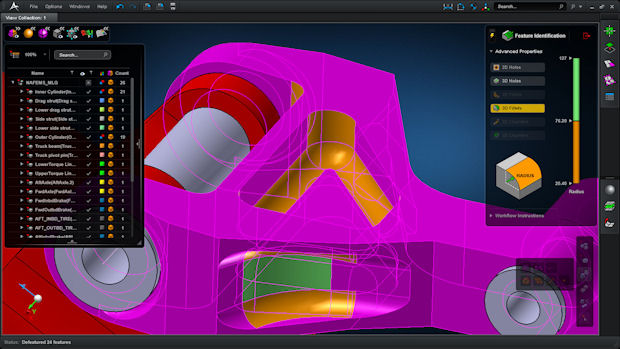Editor’s Pick: CAE Platform Has a Direct Modeling and Meshing Engine

MSC Apex Modeler image courtesy of MSC Software.
October 8, 2014
 Dear Desktop Engineering Reader:
Dear Desktop Engineering Reader:
 MSC Software just released the first component and announced the impending release of the second application in its next-generation CAE platform. Called MSC Apex, the platform will serve as the foundation “for a broad range of physics and applications MSC will introduce over time,” according to the company. This is neat.
MSC Software just released the first component and announced the impending release of the second application in its next-generation CAE platform. Called MSC Apex, the platform will serve as the foundation “for a broad range of physics and applications MSC will introduce over time,” according to the company. This is neat.
MSC says that MSC Apex is the world’s first computational parts-based CAE system. What’s that? Well, MSC describes a computational part as mathematical models that represent the behavior of a part independently from other parts in an assembly. A computational part has a boundary where it connects to other parts and sensors where users define key metrics.
But perhaps it’s best to explain what MSC Apex is not. MSC Apex is not your traditional serial approach to engineering analysis. It does not channel you into your conventional pre-processor to solver to post-processor workflow, but its workflow still returns the results you expect from such a process. Rather, MSC Apex is a fully integrated and generative simulation environment that provides full associativity between geometric and analysis data.
The key is that MSC Apex is built on a CAE-specific direct modeling and meshing engine. It supports integrated solver methods that let you interactively validate parts and subsystem models by pulling, pushing and doing all those other neat direct-modeling actions. And, yes, that means you push and pull around cells on a mesh too. Mesh updates happen in sync with your actions. Only what you changed gets recomputed, so it’s fast. MSC says that MSC Apex can accelerate your CAD to mesh process by a factor of up to 50 times and return you up to 10 times productivity gains in model preparation.
For those of you in the trenches, this means that you can create and validate parts independently from the earliest stages. You do not have to wait to validate parts during the assembly validation phase. You do not have to fix something and go through all the preparations to mesh yet again. In other words, you can incrementally design, analyze and fix parts. So, when it comes time to validate your assembly, everything should converge on the first pass. This also happens to mean you have saved a lot of time by eliminating a bunch of dreary regeneration jobs.
You can share your computational parts and assemblies with your extended design and analysis chains and still compress your workflow time. Computational parts and assemblies can be full fidelity or not depending upon how much intellectual property you want to share. MSC Apex also has interfaces to major CAD data formats and works harmoniously with Patran and MSC Nastran. That means it can slip easily into your tool chain. And because MSC Apex has integrated solvers, it can bring MSC solver technologies to organizations that could not afford them in the past.
We’re running out of room here and I have not scratched the surface of MSC Apex. The first component available is MSC Apex Modeler, which provides the CAE-specific direct modeling and meshing functionality for streamlining CAD cleanup, simplification and meshing workflow. Coming soon is MSC Apex Structures. It’ll provide fully integrated and generative structural analysis solution for engineers and analysts.
You can learn more about MSC Apex from today’s Pick of the Week write-up. You gotta hit the link at the end of the main write-up. It’ll take you to a landing page where you can watch six short registration-free videos on MSC Apex and get more details on the current product line-up. The MSC Apex Modeler and MSC Apex Structures links provide even more videos.
You can also register for an MSC Apex launch webcast to be held on Thursday, October 9, or you can request a complimentary trial version or private demo. At the end of the write-up, there’s also link to a new live webinar scheduled for October 15 that MSC just announced. It’s called “MSC Apex Methods for Simpler FE Meshing, Aerospace Applications.”
MSC Apex is not your traditional analysis environment. It truly seems a completely different way of doing your job. It also seems well positioned to shake up things. Hit today’s Editor’s Pick of the Week link and see for yourself. Really neat stuff.
Thanks, Pal. — Lockwood
Anthony J. Lockwood
Editor at Large, Desktop Engineering
Read today’s pick of the week write-up.
This is sponsored content. Click here to see how it works.
Subscribe to our FREE magazine, FREE email newsletters or both!
About the Author
Anthony J. Lockwood is Digital Engineering’s founding editor. He is now retired. Contact him via [email protected].
Follow DE





